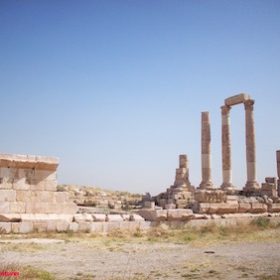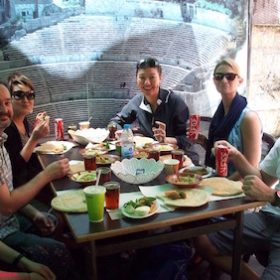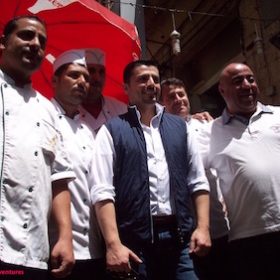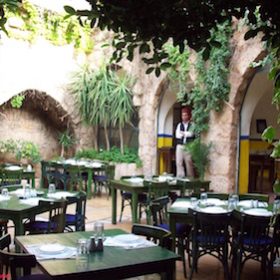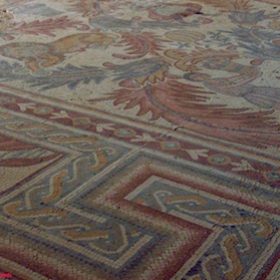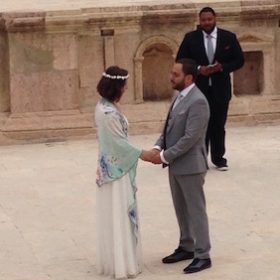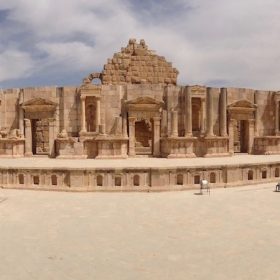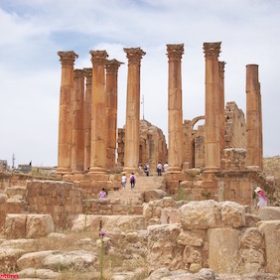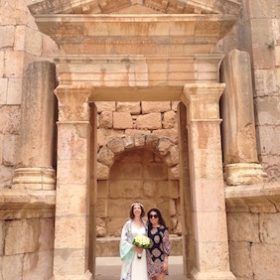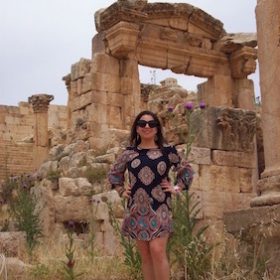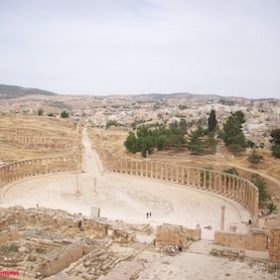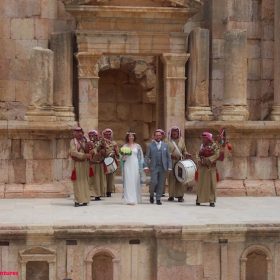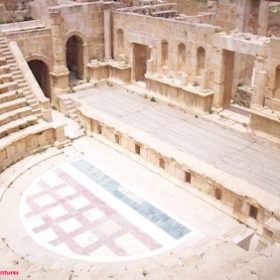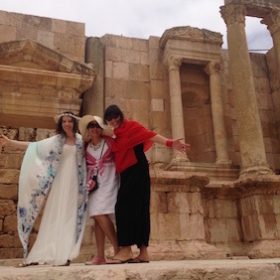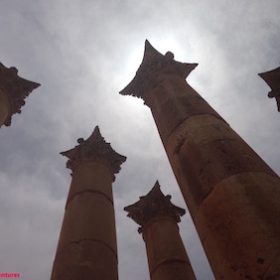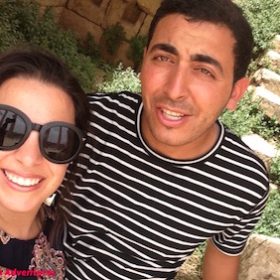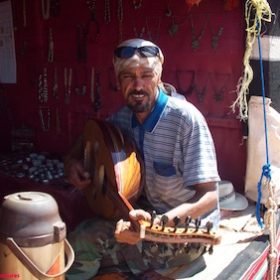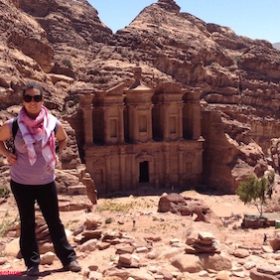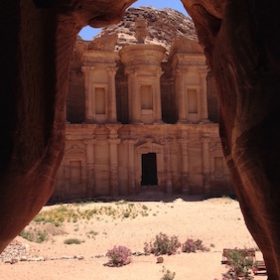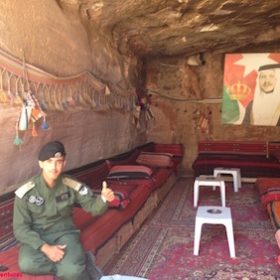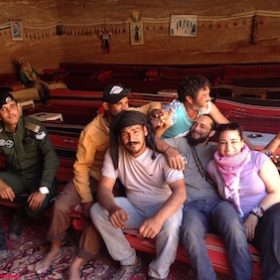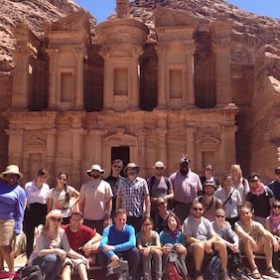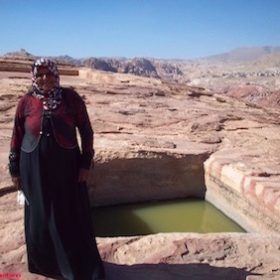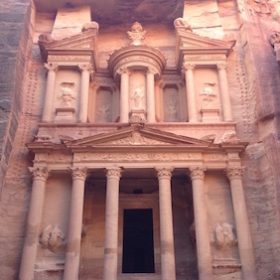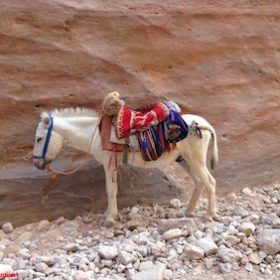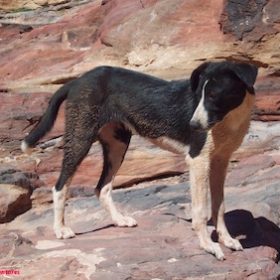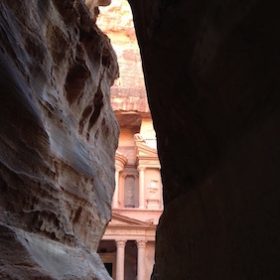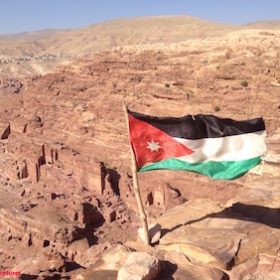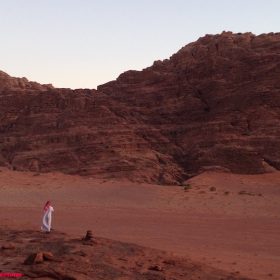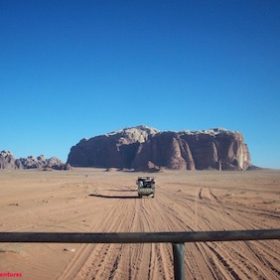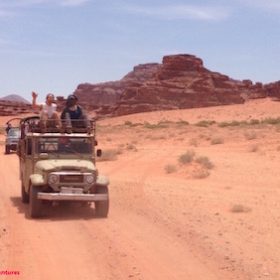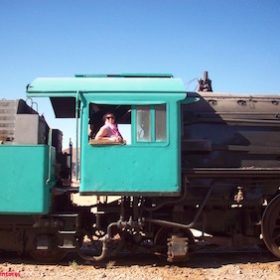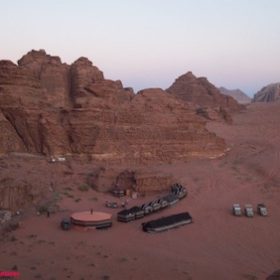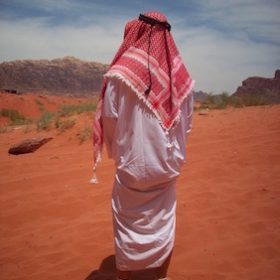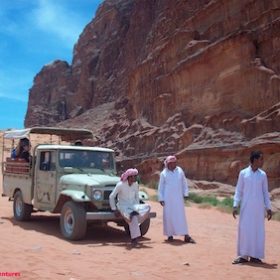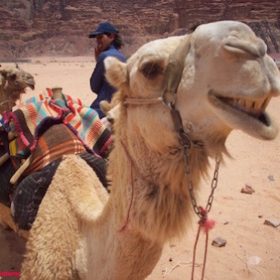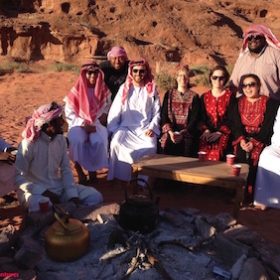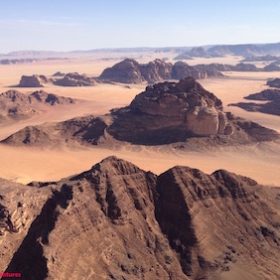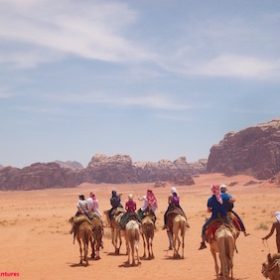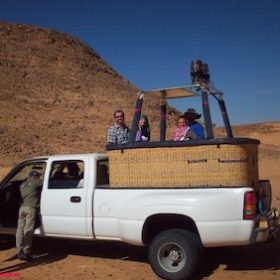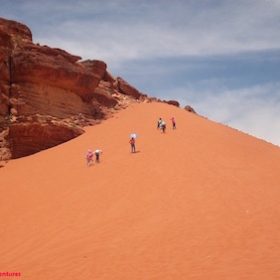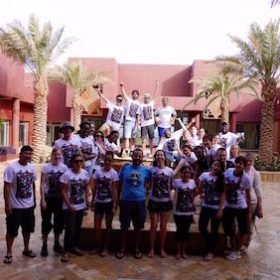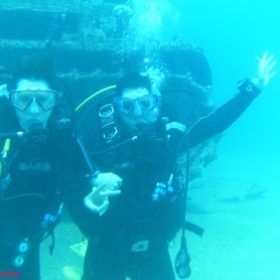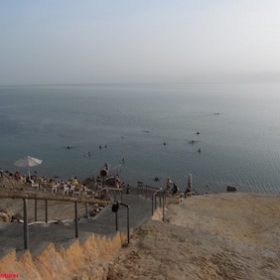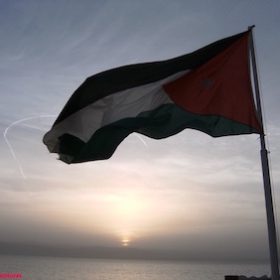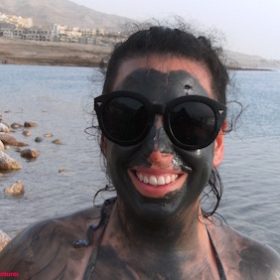In this final part of the Embolden Adventures podcast series, A Wedding in Jordan, come relive experiences of this epic adventure around the country of Jordan:
- A wedding inside an ancient Roman amphitheater at Jerash
- Flavors of the city of Amman
- The magic of the Rose City of Petra
- Bedouin desert culture in Wadi Rum
- Red Sea and Dead Sea relaxation
- Camels galore and so much more…!
In Part 1 of A Wedding in Jordan podcast series, we met the bride-to-be Jen and heard why she decided to have her wedding in Jordan.
In Part 2, we met the groom-to-be, Adam, and heard about his experiences growing up in Jordan.
In the final part of this podcast series, we follow Jen and Adam as they get married in the ancient Roman city of Jerash located near the capital city, Amman.
After the wedding, Jen and Adam took 30 of their closest friends and wedding guests from Argentina to Australia, from the US to UK and beyond on this incredible trip exploring the country of Jordan.
Let’s get this party started.
Sponsored By…
Spice Road Travel planned this adventure in Jordan for Jen and Adam and their large group of guests. It was a seamless trip that showcased the richness and deep history of this beautiful country.
Visit Spice Road Travel to learn about customizable tours you can take around Jordan, the United Arab Emirates, and Oman. Tell Spice Road Travel how you heard about them on Embolden Adventures and receive 5% off on your first Spice Road Travel booking.
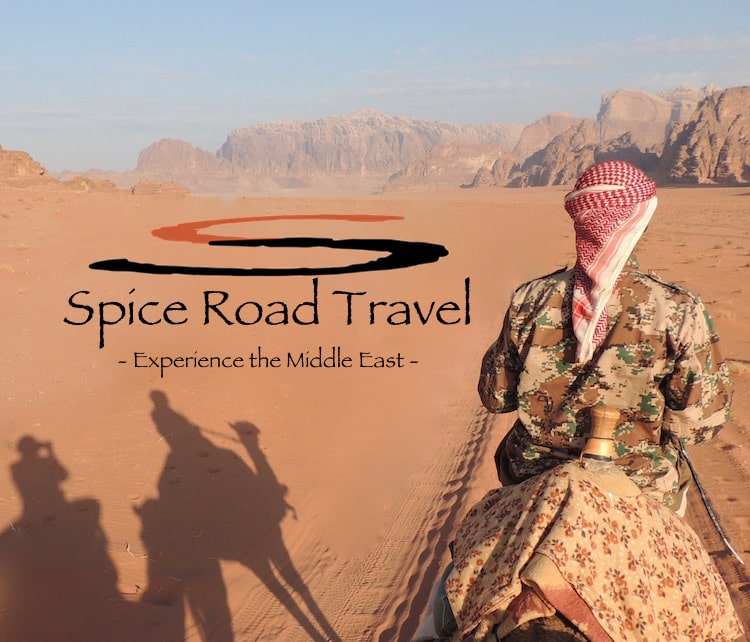
Flavors of the City of Amman
This Wedding in Jordan adventure began in the capital city, Amman, a diverse, cosmopolitan, and safe city in the Middle East with deep roots reaching as far back as the BC era.
Did you know…?
In the 3rd Century BC, King Ptolemy II Philadelphus of Egypt conquered Amman and renamed it “Philadelphia” after himself. The city continued to be named Philadelphia until reverting back to its original name, Amman after the fall of the Roman Empire. It was first named Amman when the Ammonites ruled the area back in 3000 BC.
In our first evening all together, we headed out to downtown Amman and the popular Rainbow Street area to grab some local bites and enjoy the nightlife. It was a great opportunity for all of us to meet one another for the first time or to say hello again.
Adam picked this downtown area because of its stretch of good, local street snacks. The first place we went to was this small, hole-in-the wall shop called Salahuddin that serves this delicious Jordanian egg and cheese sandwich called a ka’ak. Here they bake loaves of bread similar to a smaller version of Italian bread with sprinkled sesame seeds. Also, they bake hard-boiled eggs in the oven that creates this roasted, smoky flavor to the egg.
Over at the side counter, we put together the ka’ak sandwich ourselves, de-shelling the egg and adding it into the warm bread from the oven. Then we add a soft, spreadable cheese and a dollop of some local red chili pepper paste called shatta, and then sprinkled on a dried spice blend called za’atar. We ate this simply delicious sandwich and drank hot brewed tea with mint and sugar all for 1 Jordanian dinar or “JD” for short.
Next door was a small falafel place and next to that place was a Jordanian local sweets shop that sold different types of traditional, bite-sized sweets made out of phyllo dough, pistachios, almonds, and drizzled with honey. We all hung out on the sidewalk eating, conversing, and getting excited about the week to come.
The last stop was to a rooftop bar and hookah place near Rainbow Street where we drank the locally brewed beer. From the rooftop we had a gorgeous evening view of Amman under the stars. Out in the distance built into the hillside, I could see the many uniform, off-white rectangular buildings sometimes characteristic of the Middle East.
Here the idea sunk in for me for the very first time: We are in the Middle East!
An Epic Adventure Around Jordan – May 2016
♦ Tour Amman Jordan ♦ Celebrate Jen and Adam’s wedding at the ancient Roman city of Jerash ♦ Visit the ancient city of Petra ♦ Camp with the Bedouins in the Wadi Rum desert sleeping under the blanket of stars ♦ Take a hot air balloon ride over the Wadi Rum desert ♦ Ride a camel in a caravan through the desert ♦ Go scuba diving in the Red Sea in Aqaba ♦ Float in the Dead Sea, the lowest point on Earth ♦
Then we travel to the United Arab Emirates for the second half of the trip – An Arabian Adventure
The next day we toured around Amman and later headed to an ancient Christian town called Madaba. We started the day with a mini city tour given by Adam. He pointed out his high school situated atop one of the seven hills of Amman.
The ancient columns and ruins of Roman Temple of Hercules were located nearby. They stood high above the city at the Amman Citadel. Here we could see a panoramic view of the city and the Roman amphitheater down below.
An enormous Jordanian Raghadan flag flew in the distance. Standing at over 415 feet tall, it once was the tallest flagpole in the world.
Next we took some time to explore the old yet vibrant Bellad shopping district at the bottom of the hill. Some of the guys bargained for traditional Bedouin clothing like the long, white gown called the tob and the red and white-checkered head scarf called a keffiyeh or shemagh. Worn long on the head, the keffiyeh is held in place by a black circlet of rope called an agal. Sometimes the keffiyeh is wrapped around the head and tucked into place.
I found some of the ladies in the Palestinian dress shop trying on traditional, colorfully embroidered dresses and having a bit of a fashion show and selfie event. The dresses had long sleeves and were long to the ankle. I purchased a gorgeous, sheer black cloak with a pronounced gold embroidered trim down the opening and around cuffs of the asymmetric sleeves. I thought I drove a hard bargain, but I soon learned that a shop down the street was selling it for much less. After realizing that I bargained at a tourist price, I ended up negotiating much tougher for myself and for a few of my friends too throughout the rest of the trip. I even started to get good! Learn about how to bargain in the marketplace here.
For lunch we went to Hashem, the famous and oldest falafel place located at the edge of the Bellad shopping district. For just US$14, a large group of us ate deliciously smooth hummus and the best freshly fried falafel I ever had. With the meal, we drank the traditional hot tea with sugar and fresh mint. Also, we ordered the fava bean spread called “foul medames” and some pita bread. A chef carrying a large platter of hot pita bread balanced on top of his head placed a surprise extra pita on our table as he passed us.
Two cameramen were filming a famous Lebanese television show host eating his meal next to our table. After they were done with their shoot, he posed for photos with the chefs and waiters who later told me who this guy was.
In the afternoon, we headed to Madaba to visit Mt Nebo, a Biblical site where Moses was known to have seen the Holy Land. Mt Nebo sits atop a hill and has some views of the Dead Sea, Jericho, the Jordan Valley, and on a clear day, Jerusalem.
At this site, archaeologist uncovered beautifully preserved mosaics from a 4th Century AD Byzantine church with scenes of lions, peacocks, camels, grapes, and people wearing sandals. A large mosaic floor of the church was on display outside and some smaller examples were located inside the museum.
After taking a few group photos with the Jordan Valley in the background, we headed to dinner, but not before I bargained to buy a fossilized sea urchin some of these merchants found in the ancient valley nearby.
The restaurant we went to was in an old 20th century stone house. We had dinner in their outdoor courtyard filled with desert palm trees and flowers. At dinner we ate even more freshly made hummus and had tabbouleh, chicken kebabs, fresh salads, and a local semi-hard cheese sort of like a feta cheese. A friendly cat came around to the tables to see if she could have some of this delicious food too.
A Wedding in Jordan
This dinner was a great way to start off the wedding festivities! In the morning, we headed to Jerash for the outdoor wedding ceremony held inside the grand ancient amphitheater.
Jerash was magnificent. The ancient city first dates back to the 3000BC era, but the Greco-Roman ruins that still stand today are from around the first century AD during the Jesus era. These Roman ruins are considered the largest and best preserved in the world outside of Italy.
Called Jerasia by the Romans, it was once a prosperous trading city positioned along the incense and spice trade route to the Red Sea. It remained a modern trade route that connects Syria and the North to the Red Sea, but it has quieted down lately with the Syrian borders now closed.
When all of us wedding guests arrived, we first entered Jerash through the three-arched gateway called Hadrian’s gate, named after the Roman Emperor Hadrian who spent a year here. To the left was the Hippodrome where the Romans held chariot events and horse races for over 15,000 spectators.
We made our way up the hill to the South amphitheater. At the base of the theater, we saw scores of uniformed Corinthian columns standing tall. These columns form the outline of an oval plaza called the Forum. And one short column stands in the center. A straight roadway called the “Cardo” opens up from the oval and is lined on each side by uniformed columns standing tall.
The ancient amphitheater was grand. About 35 rows of bleacher-like benches in the form of a semi circle created the interior space. In front was a stone stage with lots of decorative columns and carve outs for statues.
The amphitheater was an old performance theater that was designed to project sound. We could hear our voices bellow with the great acoustics. Friends sitting on the benches encouraged me to sing and the only two songs I could think of on the spot were “Enter Sandman” by Metallica and The Star Spangled Banner, both I managed to sing somewhat respectfully, mostly comically.
Without further ado, we grabbed our seats on the benches and began to hear the bagpipes and the drums of the Jordanian zaffa band! In a Muslim wedding, the bride and groom celebrate their nuptials with a festive dance party complete with the zaffa band. Learn more about the zaffa band in Part 1 of A Wedding In Jordan.
Jen and Adam make their way out through the middle archway on stage and dance a bit with the band and then came down to the floor where the wedding guests joined in on the fun. A few of Adam’s friends started dancing a dabke – a line dance. The dancers interlock their arms at the shoulders and dance with fancy footwork and jumps.
Soon enough, we returned to our seats to hear Jen and Adam exchange vows. Jen had been practicing to say hers in Arabic and then repeated them again in English. Their friend and NYC cop, Adonis, officiated the ceremony. Australian friends, Gemma of the Australian pop rock band Better than the Wizards, and Yazmin, performed the Nina Simone song “Feeling Good”. It’s a new dawn; it’s a new day, just like Jen’s blog, New Dawn Wedding.
The celebration was joyous and festive and I was thrilled to be part of this beautiful moment in Jen and Adam’s life.
After the ceremony ended, we toured the area of Jerash, while the bride and groom took their wedding photos. We visited the Temple of Zeus, the smaller North Amphitheater that still had its original red and blue colored tiles on the floor, and an old church with original mosaic tiles similar to those at Mt Nebo.
Our last stop on our walking tour was to the Temple of Artemis that had lots of free standing columns. In making our own version of a well-recognized travel photo, we attempted to take the picture from the ground looking up trying to get all the tops of the 7 columns into the shot.
Ahmed, our tour guide for the trip, showed us where we could feel one of the columns move. I placed my fingers between the seams and could feel it wobble. I knew my fingers were not going to be crushed, but it was still a weird thing to experience. Someone inserted a spoon into this spacing and the spoon was moving up and down with the motion of the column.
Leaving Jerash, we headed back to Amman for the evening wedding reception held at an outdoor rooftop bar and restaurant on Rainbow Street featuring a gorgeous view of Amman, the Citadel, and the large Jordanian flag. The sunset turned the buildings on the hillside a rose color.
Another zaffa band performed at the wedding. This version was the Palestinian zaffa band complete with singing, dancing and bongo drums. The men wore white and thin navy blue striped tobs and a white keffiyeh secured onto their heads with the black agal rope. The ladies wore their traditional Palestinian black dresses with red embroidery. Some of us also wore our traditional embroidered dresses that we bought at the Bellad marketplace.
The Magic of the Rose City of Petra
Now that the wedding was over, it was time to start our adventure around Jordan! Our first stop was to ancient Petra, best known from the Indiana Jones and the Last Crusade movie.
Petra is one of the New Seven Wonders of the World and is also an UNESCO World Heritage Site. Petra is definitely the highlight of anyone’s trip to Jordan.
The ancient Nabataeans built the city and ruled the area from around 170BC until 100AD and during the Jesus era. It was a wealthy city in the desert mountains that benefited from the Frankincense and spice trade routes.
The Nabataeans thrived because of their ability to harness the water in the desert. They figured out how to direct water through terracotta pipes placed into carved channels along the canyon walls, and they created engineering feats with their dam work. At the height of their civilization, the Nabataeans grew to 20,000 strong.
Petra is known as the “Rose City” because of the beautiful rose-colored sandstone canyons from which the ancient city was carved. The Nabataeans carved multi-story, grand rock cave facades with magnificent columns into the rock walls. The architectural style is a blend of Greek, Roman, Assyrian, and Egyptian. These extravagant caves are thought to be tombs commemorating their dead. Stairways are carved above some of the doorways, signifying ascension into the heavens.
No one knows what ultimately happened to Nabataeans. A few theories are that they either abandoned the city after the trade routes changed course, or a massive flood or earthquake destroyed the city, or they were conquered by the Roman Empire.
They left the remains of a gorgeous city behind, and most of it is still not excavated. Just recently archaeologists discovered a massive monumental structure buried underneath the sand.
The people who reside there now are the Bedouls, who are also Bedouin. The Bedouls have a distinct look resembling Jack Sparrow from Pirates of the Caribbean. They have dark features and long wavy black hair. They wear black eyeliner and wrap long scarves around their heads. It is thought that these people were either the Israelites who were driven out of their land back in the day or the servants to the Indian traders who stayed behind when the traders passed though the trade route.
The main attractions to see in Petra are the Siq, the Treasury, and the Monastery.
The Siq is a natural canyon pathway that leads to the city Petra. At its entrance, an ornamental arch was in place but it collapsed back in the late 1800s following an earthquake. The smooth rock walls of the canyon rise up to about 300 to 500 feet high. And they are colored in natural earthen pastels of reds and pinks, yellows and browns. This gorge twists and turns with the way it was eroded from the wind and the water. The pathway is about 15 feet wide and you share it with the horses clip clopping down the stone path.
At the end of the Siq, a glimpse of the Treasury appears between the two slits of the rock canyon, as if it were being unveiled by curtains. The Treasury is the most famous and one of the most elaborately carved façades of all of Petra with gorgeous columns, ornate detailing, eroded statues, and an urn sitting atop its apex. The façade stands about 130 feet tall.
It is called the Treasury because legend has it, gold and riches from an Egyptian pharaoh during Moses’s time were stored inside. Bullet marks on the urn are from those shooting at it thinking gold was inside, but it’s really just a carved rock.
The other equally magnificent façade is the Monastery that looks similar to the Treasury. The Monastery is nestled up into the mountains, and it is assessable from an 850-stair hike up through the canyons.
Some other attractions you can see along the way are the numerous carved facades along the rocks cliffs, a large amphitheater carved out of the sandstone rock wall, and the ruins of what was once a Roman-like city with columns and temples. During the prosperous times, these temples had pools of water for decorative purposes meant to show off the city’s wealth and magnificence in the desert.
When we first arrived to Petra, we went on a long afternoon hike through the Siq to the Treasury. Then we continued onto a long hike up 250 stairs in the mountains to the High Place of Sacrifice.
Along the path were many Bedouin souvenir stands boarded up and closed. We later learned that tourism is now down 95% in Jordan because of the perceived danger due to the conflicts in the countries that surround Jordan. It’s such a shame. Jordan is a beautiful country with the nicest, most welcoming of people and at all times throughout the trip, I felt very safe.
Continuing up the path, I lagged behind the group. Being alone made for a bit of a spiritual experience, in the middle of the gorgeous canvas of mountains and the desert and the wind. I heard one of the Bedouins singing in the distance. Then later, I heard someone playing a flute.
I nearly made it to the top of the trail when I met this Bedouin lady. She spoke some broken English asking me, “Where you from?” The lady wanted to show me around the place: The panoramic 360 degree view of the Petra mountaintops, her Bedouin camp down below, and an old temple in the distance. From that high up, I could hear the goats and the camels making noises. Then she showed me the sacrificial altar. The Nabataeans carved the flat rock into a rectangle depression like a kitchen sink and out of one side, a drainage path.
On the way back, I ended up bargaining for some old coins that she was selling. Take my advice: Don’t buy the coins. I should have listened to Ahmed. These coins are fabrications of old Roman-like coins. I figured she found them around the area just like the found my fossil sea urchin in the Mt Nebo area. I got her down to 3JD from 10JD. I figured, “What the heck. What’s 3JD?” Take the risk. If they are real – what a return! If they aren’t – well I lost a little more than $4USD.
I thanked the lady and continued on to find the rest of the group. From here, the horizon opened up to a seamless view of all the other mountaintops. I could see the small town, Wadi Musa, in the distance as well as the Jordan Valley. My favorite picture I took of the day was of the Jordanian flag flying tightly in the winds at the edge of this cliff.
After the trek, we had a fun dinner event to learn how to make Jordanian food. We divided up into tables. Each table worked with the chefs to prepare a different dish for us all to eat. We made hot and cold appetizers or “mezzas” including baba ghanoush, tabbouleh, and the Jordanian national dish mansaf that is lamb stewed in yogurt sauce and placed over white rice and thin pita bread.
The next morning was a very early one for those who wanted to hike up to the Monastery taking the long back-route and through Little Petra. The rest of us hikers left about an hour later after an early breakfast.
Early morning Petra has this peacefulness to it. The horses were all resting so the walk was quiet. We retraced our steps through the Siq and past the Treasury. We walked past the amphitheater and the temple ruins. The friendliest black and white puppy ran over to us to say hello. She ended up following us up the mountain hike to the Monastery. We headed up along past the Bedouin caves and up into canyon. The area felt like Northern Arizona or Zion Canyon in Utah.
Some of the Bedouins passed us with their donkeys that were hauling up supplies. Some asked if we wanted to pay to take the donkeys up the path to the top– Lamborghini they’d say!
When we heard Adam in Part 2 of this podcast series, you may recall that he was part of the film crew of the movie Transformers 2. They were filming scenes at the Monastery and considered using donkeys to cart two tons of gear up to the top. Instead, they decided to transport the gear using a Black Hawk Helicopter they borrowed from the Jordanian army. After walking this path, I think that was the better of the two choices!
At the end, we arrived to the Monastery. It was hidden behind of an unassuming rock wall, and it unveiled itself as we turned the corner at the end of the trail. Across from the Monastery, a café was nestled away into a rock cave where we were happy to find our other hiking group resting after their longer hike.
A few of us forged ahead onto another path to access a high viewpoint of the Monastery and of the surrounding mountain area. On this path, I passed the cave that Karl from the TV show An Idiot Abroad, featured. At the viewpoint, a Bedouin selling trinkets was playing the oud instrument and singing.
Back down at the café, it was refreshing to take a break in the cool cave with everyone. We drank teas and freshly squeezed juices that were served to us.
At the café, I met Ali Baba, as he called himself, another Bedoul, and a Jordanian Bedouin solider part of King Abdullah II’s desert army. The solider did not speak English, but he was eager to share a bit of his story with me. Ali Baba translated. The soldier showed me pictures of him in traditional desert army royal uniforms. One picture showed him on a camel and another was of him saluting the King. He was even part of the Army that was there securing the area when Obama came to visit Petra. He said Obama took the donkey up the path to the Monastery along with the secret service.
The Bedouins and the Wadi Rum Desert
After leaving Petra, we traveled to the Wadi Rum desert to camp with the Bedouins under the stars.
On the way to Wadi Rum we stopped at an old rail line and train station build by the Ottomans. If you remember the movie, Lawrence of Arabia, Lawrence teamed up with the Arabs to fight against the Ottoman Empire back in the early 1900s, and they dismantled the Ottoman train line. The battles occurred in the Wadi Rum desert and in Aqaba near the Red Sea where we would be heading to after Wadi Rum.
An old fashioned train flying a Turkish flag was on display. We climbed into the train cars and explored around. We walked through the first class and coach cars, the engine room, and the caboose.
After the stop at the train station, we headed to Wadi Rum where we were greeted by Bedouins, dressed in their keffiyeh red and white scarves and their long tob garments, who met us in their old fashioned Toyota 4×4 pick up trucks. We were whisked away in the backs of the pick up trucks to go off-roading in the sand trails into the red desert.
If you watched the movie, The Martian with Matt Damon recently, you may recall seeing the scenery of planet Mars with the red sand and rocky mountain terrain. That background was really this Wadi Rum desert!
We arrived at the Bedouin desert campsite, and they welcomed us with Bedouin whiskey. Bedouin Whiskey is really brewed tea on the campfire with sugar and sage. After getting settled in, our group decided to climb up the large boulders next to the camp to about 50 feet high so we can get a bird’s eye view of the desert. We watched the sunset from up here turn the desert sand and the surrounding rock terrain to a pink, to a red, to eventually, a brown.
We returned to camp, and a few of us got dressed into the traditional attire from the Bellad market while we waited for our delicious zarb dinner to be served. The guys were wearing their keffiyahs and their white tops, and some of the gals were wearing their long embroidered dresses. For four hours, the Bedouins were cooking the zarb dinner, consisting of chicken, lamb, vegetables, and spices, in an underground charcoal BBQ.
After dinner, we sang and clapped around the campfire along with the Bedouins who performed for us with their oud instruments. At one point during the performance, we celebrated newlyweds, Jen and Adam with a clap, song and dance.
The campsite had a sheltered outhouse complete with a sink and shower. We slept inside the semi-permanent tents on beds and mattresses. Despite the large camel spiders, some of us slept out under the vast blanket of stars and the visible Milky Way.
Waking up the next morning, I was welcomed by an early morning peace with sunrise and the grazing camels in the distance. I sat up high on one of the rocks and just took it all in for a while.
Soon enough, it was time for us to go hot air ballooning! We went in sequential groups of two, getting door-to-door service from the tent to the balloon and back again.
The balloon was a vibrant yellow with navy blue stripes and was a stark contrast against the sand and terrain. We reached heights of 3000 feet and could see as far out to the West Bank. As the sun continued to rise in the morning, the surrounding area turned to a bright yellow, looking more like a typical desert.
Once we landed, we got a ride back to the town standing in the hot air balloon basket placed in the bed of the pick-up truck! The truck sped through the flat desert, hitting speeds of about 50 miles per or so it seemed. Then we sped onto the paved road and actually passed some of the slower moving cars. It was randomly hysterical. I never thought I would ever experience something like that!
We had a few more fun things to do at Wadi Rum before we headed on to Aqaba. First we took out the old Toyota 4x4s to go off-roading around the desert. We drove to Lawrence Springs to take a quick view of the ancient petroglyphs carved inside the small canyon walls. Next, we drove past the large sand dunes pushed up by the wind along the mountainside. And then we climbed up a naturally carved rock archway about 30 feet high and posed for a group photo.
But the best part of it all was the camel caravan ride we took back to the town.
Red Sea and Dead Sea Relaxation
Our adventure around Jordan was soon nearing its end. We had a very busy, tiring few days on the front end of the trip. Fortunately, these next few days were filled with some R&R.
We traveled south to Aqaba located on the Red Sea. This part of the country is in close proximity to Israel, Egypt, and Saudi Arabia, and they all share this small area of Red Sea coastline.
While we were there, most of us had a chance to go scuba diving and snorkeling. The Red Sea is actually very salty and a bit on the colder side at a chilly 73 degrees Fahrenheit or 23 degrees Celsius. We explored a sunken ship and an old military tank underwater, both gifts from King Abdullah II, who is an avid scuba diver himself.
Once we got to Aqaba, the heat and humidity were more noticeable. At one point, temperatures reached about 110 degrees Fahrenheit or 44 degrees Celsius.
By the Dead Sea, our last stop of our adventure, it was no better. Despite the heat, being at the Dead Sea was quite a fun experience. On the way to the Dead Sea, we did not get to hike in the Wadi Mujib because of the higher than normal water levels from the release of the dam.
The Dead Sea is the lowest point on the surface of the Earth at 1400 feet below sea level. It has 8 times more concentration of salinity than any sea on earth at 43 billion tons of dissolved salt and minerals. These minerals are very healing to your skin especially after moisturizing with the mud. Because of the salinity, the surface of the water has a sheen to it, and the rocks at the sea floor are very slippery. I tried tasting some of the seawater. It tastes like strong sour wasabi that comes with your sushi.
The strength of the sun evaporates the seawater by 6 feet each year. The water cannot be replenished with rivers or rainwater because the area surrounding the sea is just so dry. That is why you can float! We enjoyed our time bobbing up and down in the Dead Sea. It is a funny feeling unlike anything I have experienced before from swimming.
Later in day we watched the sunset over the Dead Sea. Then our group celebrated together for one last dinner before saying our goodbyes on the trip.
From Jordan, my brother, his girlfriend, and I continue on to the United Arab Emirates to explore Dubai and Abu Dhabi and to meet my Arab doppelgänger. Stay tuned for this next Embolden Adventures podcast coming soon!
This trip was quite the epic adventure destination wedding.
♥ Thank you Jen and Adam for inviting us along on your journey ♥
And thanks to Spice Road Travel for arranging the trip for the group!
Until next time Adventurers
An Epic Adventure Around Jordan – May 2016
Check out Spice Road Travel for more information on booking a trip just like this one. Ask for Sue – she can help you customize the trip you want. Email Sue here to inquire!


